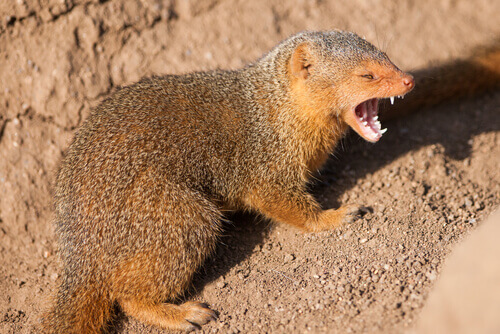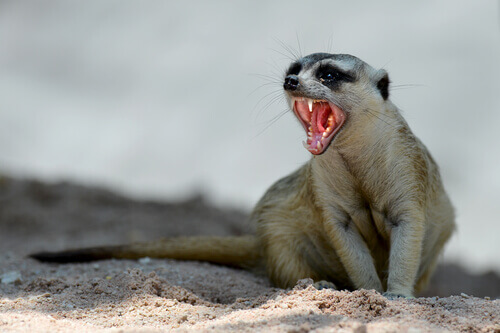The Characteristics, Habitat, and Behavior of the Mongoose

We use the term mongoose to refer to several species of mammals belonging to the Herpestidae family. The most famous species is probably the meerkat, which was a huge success among children because of its participation in animated films like The Lion King. Today, we want to tell you all about the characteristics, habitat, and behavior of the mongoose.
The mongoose: Physical characteristics and taxonomy
Currently, there are 33 known species of mongooses that make up the Herpestidae family. These small mammals have a slender, elongated body, usually measuring between 13 and 27 inches, depending on the species. Their body weight can vary from ten ounces to nine pounds, also according to the morphology of each animal.
The coat also depends fundamentally on the species of each individual. Some mongooses have abundant and thick hairs, while others have a sparse and fine coat. Colors usually range from grayish to brown, and many specimens exhibit a brindle appearance due to the dark stripes on their skin.
All species show certain physical similarities, such as the tapering snout and a pair of small, rounded ears. The legs of mongooses are short and contain powerful, sharp claws, which allow them to dig very easily. In addition, their head and body appear to form a single piece, thanks to their fine lines with smooth contours.

Mongooses possess a set of receptors that release a substance that inhibits the toxic effects of viper venom. This allows them to be very good hunters of venomous snakes, which is an outstanding ability of this species.
Another peculiar characteristic of the mongoose is its important anal gland, which gives off a strong-smelling substance. The animal gives off this odor to mark territory and also to attract attention during the breeding period.
The habitat of the mongoose
Mongooses originally inhabited the entire Iberian Peninsula, southern Europe, Asia, and southern Africa. They’re generally concentrated in forests and grasslands, but can also be found in rocky terrain.
In the 19th century, mongooses were introduced to Hawaii, the West Indies, and the Bahamas to combat rodents that were damaging sugar cane plantations. However, their rapid population growth caused an imbalance in the local fauna and threatened the survival of many species native to these islands.
The mongoose diet
Mongooses are carnivorous mammals whose diet includes insects, rodents, lizards, snakes, birds, worms, and frogs. Occasionally, they may also consume carrion and eggs of other animals to ensure their protein intake; to supplement their nutrition, they often eat seeds, nuts, and some fruits.
In the wild, mongooses tend to hunt any animal smaller than themselves, regardless of species. Although they’re noted for their ability to hunt venomous snakes, they don’t usually consume them if other foods are available.

Unfortunately, this ability of mongooses is often used, in some countries, for human entertainment purposes. In Asian markets, for example, it’s common to see organized fights between mongooses and snakes; it’s an unfortunate spectacle that puts all species involved at risk.
The behavior of the mongoose
As for the behavior of the mongoose, it’s active for much of the day, from sunrise until nighttime. Many species are social, living in burrows and forming colonies of 10 to 15 individuals. There are also mongooses with solitary habits, which come together only to mate.
In colonies, each mongoose cooperates by performing certain functions to allow the survival of its collective. Generally, the younger individuals are responsible together for the protection of the cubs and older individuals.
Mongoose reproduction
With the arrival of spring, mongooses prepare for their mating period. To attract males, females emit a very distinctive sound that resembles laughter; they usually have one litter per year, but may mate again if their young fail to survive.
Each female may give birth to three to five young per litter, which she will nurse for six weeks; after weaning, the young must learn to hunt under the guidance of their mothers.
Males usually leave the nest when the young complete their first two months of life. But hatchlings may live with their mothers all their lives in the same burrow.
